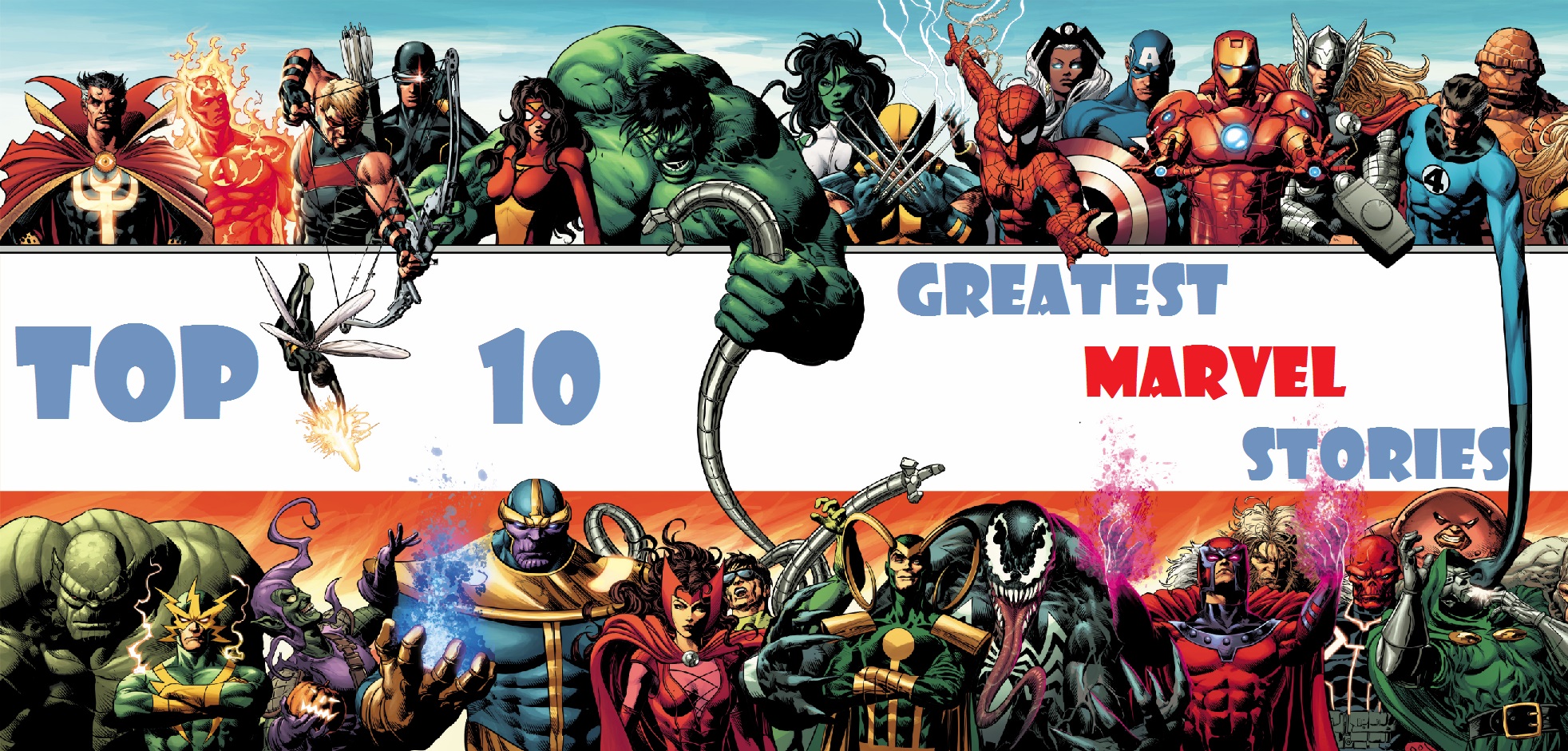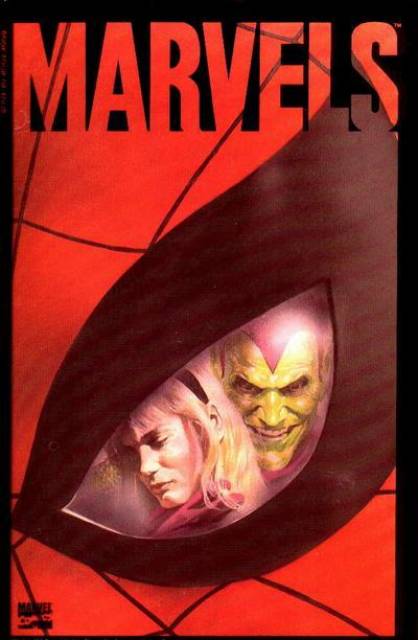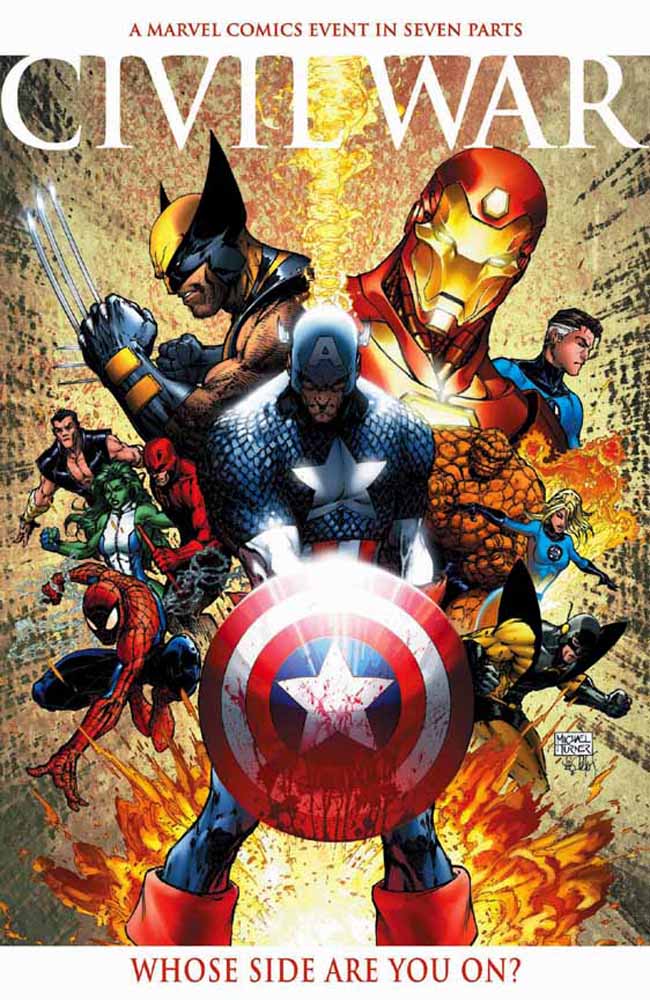
With over seventy-five years of history, and thousands upon thousands of stories, which Marvel story is the best of all time? It’s a question that has been and will be debated for years. In an attempt to scientifically resolve this issue, we at The M6P took a poll. We asked our talented contributors to list their personal favorite stories and we calculated. Our contributors suggested stories ranging from the Micronauts and Godzilla, to the Avengers and the X-Men (lots of X-Men).
Honorable Mentions:
Using our scientific survey, these stories are the near misses. Consider this a Top 26 Tuesday. Every title here was just one vote away from being on the Top 10.
Punisher: Confederacy of Dunces
Secret Invasion
Thor Vol. 3 #1-12
Punisher Kills the Marvel Universe
Rise of the Midnight Sons
Fantastic Four Vol.1 #6
Wolverine Vol. 3 #32
Giant-Size X-Men #1
Annihilation
Avengers: The Children’s Crusade
Amazing Fantasy #15
X-Tinction Agenda
Earth X
Weapon X
Thor: God butcher
Top Ten lists are made to be debated but this is the official The M6P Top 10 Greatest Marvel Stories of All Time!

10. Uncanny X-men (vol. 1) #143
By John Coughlin
The only creators to appear on this list twice are Chris Claremont and John Byrne. In a story simply titled “Demon” they craft a classic underdog tale. A very young Kitty Pryde is left home alone on Christmas Eve when a powerful demon infiltrates the X-Mansion. Using what little control she has over her powers, Kitty leads the demon on a chase that practically destroys the mansion, before using the Blackbird’s thrusters to finally destroy the monster. This story proves you don’t need a seventy- five issue crossover to tell a good story. It’s a tale that endeared countless readers to Kitty Pryde. In one issue these master storytellers gave us enough drama, action, and suspense to keep us coming back to the X-Men for years.

9. Marvels
By Jon Durmin
To fail to include Marvels on this list would be a disservice, not only to its authors, but also to you super citizens of our followers. From the vantage point of Daily Bugle photojournalist Phil Sheldon, Marvels is an era-by-era biography of the Marvel Universe as experienced by the ordinary people that live in the shadow of the wonders & marvels of this world that otherwise parallels our own. Sheldon’s experience provides a front row seat to such key moments in the Marvel Saga as the Sub-Mariner and Human Torch‘s battle through Manhattan, Mutant-phobic riots in response to the Sentinels, the coming of Galactus, and the death of Gwen Stacy from the position of an observer, as portrayed through the brilliant paintings of Alex Ross. Via scribe, Kurt Busiek’s flawless narration of Sheldon’s experience, we also experience the conflicting strands of elation and insecurity a normal human in a world of superhumans would be subject to. Not only did this series launch a potent career trajectory for its able creators, it was a true game changer for fans at the time of publication. In an era where “image” prevailed over substance, and the comics industry had gone from boom to bust, Marvels reminded fans and critics alike of the artistic potential and narrative value of this medium, and affected a renaissance in quality of publication that would last well into the coming millennium. When it comes to great comics stories, make mine Marvels!

8. X-Men: Second Coming
by Aaron Schappel
Second Coming is an X-universe-spanning epic running through three issues each of New Mutants, Uncanny X-Men, X-Force, and X-Men: Legacy as well as bookend issues. Back when the X-Men only had 198 mutants in existence, they lived on an island off the coast of San Francisco called Utopia. A reanimated Bastion set out to destroy the remaining mutants, raising a few of his own baddie buddies to bring along to the fight. After Hope, the mutant ‘messiah’ returned to the present (from a previous and equally compelling story), Bastion began his last assault on Utopia, holding the remaining mutants inside using a gigantic force field and, in what is one of the saddest parts of this story for me, taking out every teleporter including my beloved Nightcrawler. Reading the issue where Nightcrawler dies gets me every time. He died a hero and his sacrifice inspired Hope to activate her latent mutant powers and eventually defeat the android fascist with the help of the other capable X-Men.
This X-over was a compelling end to two years of mutant publishing and it had an emotional crescendo with a satisfying conclusion. For the complete picture, I’d recommend reading “Utopia”, “Nation X”, “Necrosha”, and “Messiah CompleX.” Just reading up on this again is getting me nostalgic. I think I’ll have to dig those issues out again!

7. Onslaught
by Jarid Mayo
When Onslaught was released I was 13 years old. Juggernaut was knocked from Canada to New York by a mighty being named “Onslaught” during the first issue of Uncanny X-Men after Age of Apocalypse had ended. Juggernaut was THE force to be reckoned with so this new character must be pretty powerful. For months, the various X-Men titles would give hints and clues about Onslaught but nothing more.
Eventually Onslaught was revealed as Professor Xavier (with a little bit of Magneto)! Not only was Charles a new villain for the X-Men and the Marvel Universe, he was also revealed as the X-Traitor from Bishop’s future! For a boy that couldn’t get enough X-Men, this concept blew my mind.
The entire Onslaught storyline was 90’s comic book goodness from beginning to end. Very few Marvel crossovers really included the majority of the Marvel Universe characters, but Onslaught sure tried. Ramifications of Onslaught were felt in titles like Punisher, Amazing Spider-Man, and Incredible Hulk. The New Warriors even battled Onslaught’s Sentinels!
The Onslaught storyline wrapped up in Onslaught: Marvel Universe. The X-Men, Avengers, Hulk, Fantastic Four, and more combined their powers to take on this uber menace! Onslaught created a second sun, turned into a being of pure energy, and was ultimately defeated by the Avengers and Fantastic Four sacrificing themselves to end his reign of terror.
The Onslaught saga had lasting ramifications on the Marvel Universe for years later. Heroes Reborn, Operation: Zero Tolerance, The Thunderbolts, and more were all directly created by the Onslaught crossover.

6. Nextwave: Agents of H.A.T.E #1-12
by Kevin McVicker
What do you get when you pit a band of D-List superheroes(at the time at least) against Fin Fang Foom, genetically modified vegetation, a mentally unstable Nick Fury analog, and a dinosaur in smoking jacket? You get Nextwave: Agents of HATE! The comic series equivalent of a roasting, Nextwave was not afraid of heavily referencing the overall ridiculous nature of comics while at the same time showing great love and appreciation to that insanity. The series reads like a giant “in-joke” for long time fans of comics. It wentso far as to even mock the uniform covers of the tie-in books for the then occurring Civil War series with issue #11. It is the closest thing we as comic readers will ever get to having Douglas Adams write a comic, and because of that I, like so many others probably, started my lifelong love of Warren Ellis. Ellis and Immonen gave us fans just enough with the twelve issue series to want more, but knowing full well that there was magic captured in this run that made it perfect and complete.

5. Captain America: The Winter Soldier
by Bradley Allen
First and foremost, what Brubaker has done for Cap in his Winter Soldier story, and his entire run on the character, is introduce you to Steve Rogers; a Steve Rogers that must now be Captain America in what our country has become. This isn’t brightly-colored, fight-Batroc-and-Everyman-on-a-high-wire-between-two-blimps-with-a-star-spangled-salute Cap (which I love). This is my-nation-is-being-torn-apart-inside-and-out-by-people-who-hate-what-we-have Cap (which I love). This is Captain America in the here and now. The REAL here and now, and what he would ACTUALLY do and how he would ACTUALLY react. He’s beaten, battered, tired, manipulated. The Avengers have “disassembled.” His long-thought-dead friend has been alive all this time and is a mindwiped assassin for the enemy. While Steve’s definitely still in-character, it IS refreshing to see an unsure and erring side of the usually-infallible Sentinel of Liberty. For all intents and purposes, it is a very modernizing story (which I don’t usually love), but Brubaker doesn’t neglect the more grandeous aspects of the superhero world, while he grounds it with real-world urgency.
Additionally, Ed Brubaker’s eerily-on-point knowledge of the character certainly shows with the entire story. One of the things I loved MOST about the Winter Soldier story was that every issue is built on a classic element of Captain America storytelling. It’s almost as if Father Bru had a checklist of classic Cap tropes and devices to check off as he went along. He’s got the old-stand-by SHIELD assault issue, the team-up issues with guest appearances from past Cap cast members like Union Jack (whom I love), the Invaders (whom I love), & Jack Monroe (whom I could take or leave) and the WWII flashback issue. This is where Brubaker really hits his stride and shows his love for the character and mythos. Flashbacks are seamlessly woven back into the larger story and utilized to his great advantage. These remembrances are used to expand on and clarify villainous motivations, drop little Captain America factoids to help newer readers understand the depth and importance and fan service of the narrative, or to simply drive certain points home.
Lastly, one could not have asked for a better artist for this character revamp. Steve Epting’s crisp pencils and muted chalk-like inks have this air of rigid seriousness that fit the tone perfectly while allowing for tons of movement, life, and excitement. Vibranium bounces, bones crunch, things go kaboom! The covers are each on their own level of incredible and include possibly the new, most iconic Captain America masterpiece of all time that graces the cover of Captain America Vol. 5 #4. A very stoic Captain America, shield in hand, stands over the graves of his fallen brothers-in-arms at Arlington cemetery; a powerful and perfectly rendered moment for our hero.
This is truly, for me the single greatest Captain America story ever told. Every device, formula, quip, onomatopoeia, wingtip, and pirate boot that has ever been used to make a Captain America comic great, is used again in this story arc. The story is compelling. The art is fantastic. Long time fans can have a read and pick up on a vast wealth of hidden fanservice, and new readers can open it up and gain a deeper understanding of what it is that really makes Steve Rogers tick. Do you prefer the soldier or the symbol? Doesn’t matter. This book brings fans together. This is sequential comicbook storytelling in its purest, hottest form. This. Is. Captain America.

4. Civil War
by Jen Cappelli
As an impressionable youngin that had long been mocked for comic geekery, (OMG NO WAI GIRLS CAN LIKE COMICZ TOO GUIZE) Civil War came at a very important time for me. I was in the crucial point of my life where I was to decide whether to hide my 15-year-running comic love (age 5-19 as of 2006), or finally pull the knitted afghan off my long box when people visited my dorm. My entire fandom had been steeped in 90’s Spidey back issues until this event. Now living in the college city taking graphic design, I had direct access to the comic store—WHENEVER I WANTED. AND WITH..MY STUDENT LOANS.
While the comic universe was being split in two over dramaramas, the video game Marvel Ultimate Alliance was bringing its own together. It was a very good time to be a Marvel fan and with the combination of both, I was out of my back issues and left intrigued by all these characters I had never even heard of. (“Spider-Man who’s under-powered…. Blade….Iron Man….and 15 not-Spider-Mans.”) With the helpful push from the budding scene of niche comic podcasts while working on ungodly projects, I was easily convinced to go out and read the ever loving nanites out of these new books.
Civil War was a story that not only reflected a split of mentality in modern American politics post 9-11 (The ONLY essay I ever wrote in college was about this), but was one of the early well-marketed (borderline viral with memes) events in modern Marvel history. Say what you will about its status as a jumping on point, it worked for me. The art was purely top of the line like I had NEVER seen before, it read like a serious drama, and it DID have some of the longest-reaching ramifications that I had known since the Black Suit. It was a perfect time to buy books you’ve never read because EVERYONE was dealing with the registration—Great Lakes Avengers, The Shroud (who?), Deadpool (Not such a big name back then), Moon Knight… from A listers to Z listers, this affected everyone.
As a huge Spider-Man fan, I was ecstatic to see him be a massive keystone, and his unmasking was truly a ‘WOW’ moment. JJJ’s reaction will be with me forever. Around the end of this event’s main series, I found myself hired onto a Spider-Man-centric podcast and VASTLY enjoyed combing through his aftermath in over 9000 titles at the time. Back in Black, the Kingpin fight, etc. Whenever someone asks me where they should start or for a recommendation, I always suggest this book. We said in 2007 it needs to be a movie someday and I had absolutely no inkling whatsoever that it would actually happen.

3. The Dark Phoenix Saga
By John Coughlin
In the Dark Phoenix Saga, Chris Claremont and John Byrne gave us the first appearance of Kitty Pryde and Dazzler, the amazing “Wolverine: Alone” issue, introduced us to the Hellfire Club, and most importantly told an amazing story. Jean Grey is seduced to the dark side by Mastermind, but as her mind unravels she unleashes the power of the Dark Phoenix. The Phoenix is an elemental force more powerful than anything the X-Men have ever seen. At one point she consumes a star and wipes out an entire planet filled with billions of D’Barai living beings. The X-Men, Sh’iar, Kree and Skrulls all debate how to handle Phoenix. Can she be redeemed? Should she be destroyed? Ultimately it is Jean Grey who decides her own fate. At a time when death held weight in comics, Jean heartbreakingly sacrifices herself rather than risk unleashing the Phoenix Force on the universe again. As Uatu says “Jean Grey could have lived to become a god. But it was more important to her that she die…a human.”

2. The Age of Apocalypse
by Louis Serafine
The Age of Apocalypse was groundbreaking. For a couple of months between 1995 and 1996, all of the existing X-Titles were individually replaced by new titles, with alternate versions of our favorite X-Men and X-Men adjacent characters. I was 13 when it hit, and as a comic reader and X-Men fanatic of about 5 years, I had never seen such a massive crossover story arc. It was unprecedented! Even at this young age, I knew crossovers sometimes had a tendency toward feeling hokey and forced, but what made this enormous story so remarkable is that it was genuinely good; great, actually.
I think a lot of comic fans love to see alternate versions of their favorite characters, and for these fans the AoA delivered. These new incarnations weren’t just different-for-different’s-sake; they were natural and authentic to the spirit of their 616 counterparts. The writers of the AoA had a respect for and understanding of their characters. This, combined with amazing artwork, (such as the iconic, beautifully-angular faces of Joe Madureira,) and unique, new-feeling, immersive plots within a cohesive frame story, made the Age of Apocalypse a product of profound quality.
The AoA was bleak. It was brutal, violent, and gruesome, but it was never gratuitous.
It was dark, but the struggles of Magneto, the X-Men, and those working to defeat Apocalypse represent universal themes of hope, selflessness, and heroism in the face of insurmountable difficulty that imbued the Age of Apocalypse with an inherent, heart-felt nobility.

1. The Infinity Gauntlet
by Skott Jimenez
The Infinity Gauntlet is without a doubt my favorite Marvel story. It had a scope that hasn’t been matched since. This story was my introduction into the larger Marvel Universe. In 1990, I started collecting comics with Ghost Rider and I followed him through the different books he guest starred in. This event blew open the doors of the 616 and showed me many more characters, many of which are still favorites of mine.
Another thing I still love about this is Thanos still feels like a threat in this story. Today he, and the Gems, are popping up every other week and they just don’t have the impact they once did. Back when this story was going Thanos still had an air of danger about him. He killed half the sentient beings in the universe by snapping his fingers and thought nothing of it. He didn’t have followers who did work for him, he was a force unto himself and this story showed that to an entire new generation of fans.
Lastly, the story was contained. Yes, it was massive, the main story had 6 issues and it crossed into most of the Marvel books at the time but, unlike today, it didn’t continue to grow. It was also not hindered by multiple delays. Marvel should go back and examine why this event still stands tall today because it was, in my opinion, that last truly good Marvel crossover/event.


